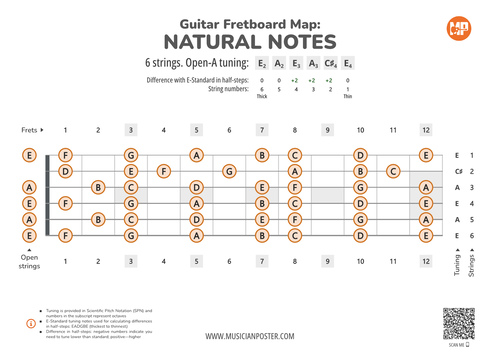Map of all natural notes (A, B, C, D, E, F, and G) across the entire fretboard for a 6-string guitar in Open-A tuning. Whether you're a beginner learning the notes or an experienced player exploring new tunings, this map will prove to be an invaluable resource.
This core set of notes (compared to a chart that has both naturals and accidentals) offers the benefit of simplicity, focus, clarity and ability to visualize fundamental music theory concepts. For example, when we start learning the music alphabet and our first chords it's usually the notes of the C-Major scale, and the notes that make up the C-Major scale happen to be all natural notes. The same applies to a common A-Minor scale, which consists only of the natural notes.
In fact, here's a list of highly popular scales that use only the natural notes:
- C-Major
- A-Minor
- A-Minor Pentatonic
- C-Major Pentatonic
- D-Dorian
- E-Phrygian
- F-Lydian
- G-Mixolydian
And here's a list of common chords that can be constructed just from natural notes:
- Major chord
- Minor chord
- Dominant 7th chord
- Major 7th chord
- Minor 7th chord
- Diminished chord
- Half-diminished 7th chord
What this means for you is that if you want to explore those scales or chords and arpeggios within those scales then this single diagram covers them all.
How You Can Use This Chart
Here's a list of scenarios where you may find map like this to be really helpful.
- Visualize and memorize locations of natural notes on the fretboard.
- Find different chord voicings, inversions or shapes.
- Understand common scales in different positions across the fretboard.
- Explore modes of the Major scale.
- Find convenient patterns to play common arpeggios.
- Experiment with different instrument tunings.
But you are free and encouraged to come up with other uses as well and share them in the comment section below, I'd be happy to read your ideas. That way you are also sharing your experience with the rest of the community.
Features and Benefits of the Chart
- 12 and 24 frets: The charts are available in two variations: as 12 frets and as 24 frets.
- Doubled frets: Fret numbers are provided both below and above the diagram, offering additional visual cues to pinpoint your location and navigate the fretboard with even greater ease.
- Tuning in SPN: Tuning is provided in Scientific Pitch Notation so you get to see the octaves of each pitch without the need to look up a different reference. If you're unsure what they mean or what they are for you can just ignore them.
- Tuning Difference: As you explore alternative tunings, you will soon discover that you want to know how much they differ from the standard/factory tuning based on the number of strings your instrument has. This chart shows this difference in half-steps for each string, where negative numbers indicate that you need to tune lower than the given standard tuning, and positive numbers indicate that you need to tune higher. If you're not yet interested in this information you can just ignore it.
Alternative tuning spellings
For those who search for this content based on the tuning names, here are alternative spellings to increase the chances:
- EAEAC#E
- E-A-E-A-C#-E
- E2-A2-E3-A3-C#4-E4














0 Comments